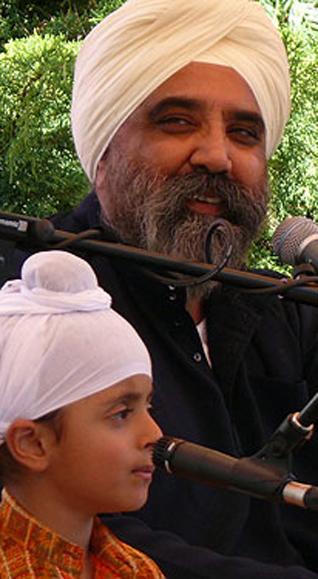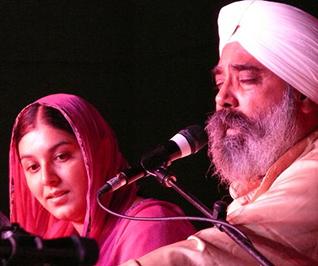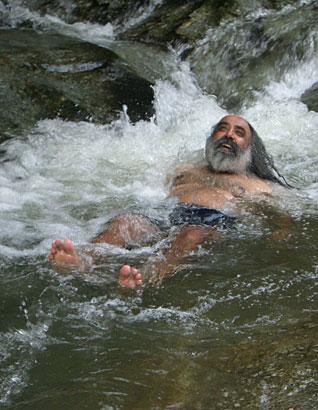Our Heroes
Ruined It For Me
by T. SHER SINGH
The story still reverberates with me, even though it’s been several decades since I first overheard it as a teenager.
I don’t remember the names of its protagonists … it is even possible that it may be apocryphal. But, regardless of its authenticity, it made its point well, and it remains seared on my consciousness.
An elder, renowned for his piety - the story goes - was sitting with a few members of the sangat when their conversation was interrupted by a burst of song from the next room. The baba closed his eyes to soak in the shabad, while the others too quietly listened to the verse being sung by the lone but unknown soul.
The elder shook his head sadly, winced a couple of times visibly, and then got up and moved to a spot out of earshot of the singing. As the group followed him across the yard, he turned to them and whispered to them: “Gurbani, if sung with love and devotion, has an inherent sweetness to it. This one, however, hurts the ears! He should stick to silent meditation!”
The story has stayed with me.
Understandably, therefore, I have stayed away from ever bursting into song, unless I’m securely inside a shower.
And I’ve gone further. I have tried to learn to discern between good raagis and the rest. It requires no science - the heart is the perfect gauge. But as I grow older, I find that I’m becoming even fussier in my choice, and the number of those I gravitate to, I am grieved to say, grows steadily smaller.
Having grown up in Patna, the site of one of our Takhts, I have fond memories of stalwarts who, certainly on major gurpurabs if not on other occasions too, regaled the sangat with heavenly kirtan.
Names like Bhai Surjan Singh and Bhai Gopal Singh, Bhai Mohan Singh from Bombay, Bhai Lal ji from Lahore and Bhai Chela Ram from Delhi, come to mind immediately. I still seek out their recordings, and they still grip me with the very first strains that reach my years. Prof. Darshan Singh of Canada and the late Bhai Avtar Singh are two of the more recent names.
There are others, of course, but most of them only sporadically reach lofty heights, not unlike the pop stars of the music world who hit the charts for a while and are then never heard of again.
To a large part, my finickiness is to be blamed on Dya Singh.
He has ruined it for me.
The more I listen to his rendition of the shabads, the more I become addicted to them, and the more exacting I have become of what I expect from the clusters of raagis that migrate seasonally between the continents, country to country, city to city, gurdwara to gurdwara.
I say it with a heavy heart that, more often than not, I get little pleasure from the kirtan I get to hear in some of the gurdwaras today.
As the wise old man pronounced so honestly in the story above, there is often more music in silence than in some of the stuff that passes as kirtan nowadays.
I am no purist and do not necessarily want everything sung in accordance with the recommended raags. Even though, indeed, nothing beats the ambrosia of bani when presented exactly in the way the verses were meant to be sung … when accompanied by complementary instruments, in voices that convey love and understanding, and sung in the raag that reflects the mood, the thrust and spirit, the very ambience conjured up by the words.
Bhai Avtar Singh’s many tapestries that survive him on CDs prove my point.
But, as I said, gurbani does not have to be sung in raags to inspire one or to transport one beyond the stratosphere.
Also, there is no reason why we need to limit ourselves to traditional forms when seeking inspiration and soul food in spiritual music.
Surely, Guru Nanak did not clap his hands over his ears when he arrived at the Hindu temple of Jagannath Puri and found them doing an aarti to the idol. We all know how much he abhorred the ritual and the superstition and the idolatry, but we also know that the chant he heard there inspired him to compose one of his most beautiful compositions: “gagan mein thaal …” - “Let the sky be the salver …!”
Again, surely, he must have been deeply touched by the azaan (the Muslim call to prayer) in Mecca, for its imagery resonates over and over again in his poetry.
I must confess that oftentimes I find myself turning to Nusrat Fateh Ali Khan’s meditatative “Ali! Ali!”, or the vedic chants produced by Ravi Shankar. Their exquisite weavings take me on space travel, a journey I find increasingly difficult to embark on when served the modern-day fare being offered in some of the gurdwaras.
My persnicketiness is not entirely the fault of the raagis, of course.
If there is one man to blame, it is Dya Singh.
Yes, he has ruined it for me.
Once you’ve heard Dya Singh, it is difficult to go back to run-of-the-mill kirtan.
He sings gurbani the way it is meant to be sung … the way, I’m sure, the baba in the story would have enjoyed.
His booming voice envelopes you, his larger-than-life presence picks you up, and takes you along … you are thereafter at its mercy.
If you see him sing, you can’t help noticing that he enjoys what he does. It invigorates him. His high-energy is catchy. His fellow musicians find themselves in the same zone.
He is gifted like few other raagis I know. He is equally adept with raags, folk traditions, pop trends, and the different music systems of the world’s faiths. Maybe that is why he is often labelled as multi-cultural or an exponent of ’world music’, but I don’t think any of these labels do justice to him.
The first thing I ever heard by him was the multi-faith invocation that has now become his trade-mark - wherein he beautifully, accurately and respectfully renders the credal chants from the world’s major religions: Christian, Hindu, Muslim, Buddhist. And so on. Culminating in a starburst of Nanak’s celebration of the Universe, and Gobind Singh’s paen to the Creator.
It was two decades ago. I was in Orlando, Florida, attending the Hemkunt Foundation’s annual children’s convention, when I overheard a magical sound emanating from someone’s Walkman. I asked and was told it was a singer based in Australia.
Where could I get a copy? The directions she gave me sounded too convoluted for one who was seeking instant gratification. It took me the whole weekend to convince her to part with the cassette … I had to use every ounce of my skills in advocacy.
From that point on, I was hooked.
It took me a couple of years to get another album or two, and then, finally, I was able to tap into the treasure-lode directly.
Now, I have a garden of delights to choose from.
Just yesterday, driving the distance to Toronto and back, I had lined up my favourite CDs for the three hours of the round trip.
With Dya Singh singing “tujjh bin khari nimaani ..” - “Forlorn an I without Thee …”, and “mil raam pyaarey …” - “Come hither, My Love …”, my Toyota Matrix turns into a speeding gurdwara and the journey turns into a spiritual experience. [These two in particular often remain on “repeat” for an entire journey.]
Then there's the Jaap Sahib, sung to a rap beat - ideal for my treadmill chore! The minutes, otherwise interminable, simply fly by ...
It’s not just Dya Singh.
He is accompanied by his equally (some would say, more!) talented daughters, one or two or all three, depending on the CD; and by a band of equally extraordinary musicians doing their magic on an array of instruments. Exotic ones, some of them. Mardana would have given his eye teeth to get his hands on some of them, I bet.
All of this adds several dimensions to the kirtan.
Male and female voices singing together!
How did we ever get into the tradition of mere male raagis, for heaven’s sake?
And then, Dya Singh’s personal instrument of choice is the usual harmonium, but his experimentation with the most obscure instruments imaginable is such a breath of fresh air. A didgeridoo! A ukelele! One wonders, how did Nanak and Mardana ever manage without them while singing under the stars?
That’s what I mean. It’s not one thing.
Dya Singh is a bundle of innovations, all of them delightful, and once you have dipped into his box of chocolates, nothing ordinary will do any more. Certainly for me personally - I can‘t speak for others - he’s ruined it for me.
What fascinates me about him is that he lives life to the fullest. I admire people who are well-rounded and have more than mere work or prayer as their full-time preoccupation.
I am distrustful of those, for example, who are steeped in religion full-time and who do nothing else with their lives.
I like the fact that Guru Nanak was a farmer … and a poet, and a world-traveler. That Guru Arjan was a building contractor (wasn’t he?) … and an editor and a publisher. That Guru Gobind Singh was a soldier and a statesman … and a patron of the arts.
Recently, here in Mount Forest where I now live, I have discovered the friendship of a few Mennonite families. I love the fact that every time I visit one of their ministers for a chat, I invariably find them harvesting apples, or milking cows, or on a tractor or combine, tending to their fields. Not in ritual or seclusion.
Likewise, I like the fact that Dya Singh does more in his life than just sing shabads.
I had the pleasure of seeing him in his natural habitat a few years ago, amidst the jungles of Malaysia.
He loves food. He drives miles to get to the right dhaaba.
He loves travel. Getting to see Malaysia through his eyes was like truly discovering a country.
He loves walking and hiking. I am sure you’ve read about his annual walkathons when he covers a couple of hundred miles over two weeks, and raises money for worthy charities.
He loves life. One of the most delightful images I have in my mind’s eye - a vision I often seek out when it stays grey and cold outside my window for too long - is the sight of Dya Singh’s head bobbing in and out as he swam in a brook and spring in the vicinity of a waterfall deep in the forest, oblivious of a family of monkeys inching towards us, anxious to reclaim their territory.
He thinks outside the box, and therefore is a creator and an innovator. Learning from the Gurus - Guru Nanak had no compunction in having a Muslim minstrel as his life-long accompanist, nor did Guru Gobind Singh turn away non-Sikh disciples - Dya Singh ropes in some of the most talented musicians you can find anywhere, as part of his entourage. And guess what, many of them are not Sikh!
And guess what? They make beautiful music, the most exquisite kirtan you’ll find anywhere.
Dya Singh is a man with no boundaries.
Now, that is what makes a great raagi … one whose zest for life flows freely into his song. You can feel his spirit soar as he sings.
Lord! That baba, whoever he was, would have loved Dya Singh’s sound.
This simple man - straight-forward, honest, unpretentious, and often blunt-spoken - is, I believe, one of our great living treasures.
There aren’t too many people around that I turn to for spiritual succour.
He’s one of them.
November 21, 2011
Conversation about this article
1: Sangat Singh (Kuala Lumpur, Malaysia), November 21, 2011, 3:21 PM.
What better tribute could be paid to the Maestro who sang from his heart and took you in the wake of his flow, and you are helplessly changed for ever.
2: G.S. Bhuller (Chester , Virginia, U.S.A.), November 21, 2011, 10:13 PM.
Dya Singh has shown us that kirtan is not the particular territory of professional raagis. Kirtan can, and should be, played in the culture that surrounds it, while not forgetting the original roots and the raags. The interesting thing about all the purists who jump up and down when someone does kirtan on anything other than a vaaja or tabla is that they forget that neither the vaaja nor the tabla were in use in the Guru period. Stringed instruments - the rebab, taus, sitar and saranda - were accompanied by the dhol or the pakhawaj. The voice that sang was a cultured voice. As we go forth into new times and new lands, let us explore more new instruments and styles and make kirtan relevant to the youngsters of those regions. The raags and reets should not be forgotten - the charm of classical raag cannot be replaced. But kirtan can be done with other instruments and other styles also. I am so grateful to Dya Singh for showing us that this is possible, and, when done well, beats many who perform in the gurdwaras today. Sadly we only have a handful of rebab, saranda and pakhawaj players alive, but it is heartening to note that their numbers are increasing.
3: Gurmukh Singh (London, United Kingdom), November 22, 2011, 3:33 AM.
Dya evokes, provokes and leaves a lasting impression with all those who listen to his kirtan. I can well understand the harsh criticism as well as the eulogies which he receives; both, most deservedly! Brought up in the evergreen Sikh Kirtan tradition, I do not relate to some of his earlier adventures outside the beaten musical track. Yet, surprisingly, those like late Bhai Avtar Singh heard Dya's fusion music approvingly. Recently S. Khushwant Singh (New Delhi) has written about him. He is the youngest of three brothers, and relates well to the younger generation. He remembers me only with a beard. I recall that the bandash (tunes)of the shabads Sher Singh has mentioned so appreciatively are those of our father, late Giani Harchand Singh Bassian of Malaysia, a Punjabi teacher and gurbani sangeetkar, also forced by circumstances to work as a gurdwara granthi from time to time. Dya sang with him from a very young age - actually, I recall Bapu ji doing Asa ki Vaar with baby Dya lying next to him! With "dukh bhanjan tera naam" as his latest long album of 35 shabads with music "arranged" by the renowned Craig Preuss, Dya has come closer to his ultimate goal of producing a distinct "Sikh World Music".
4: Tarsem Singh Ubhi (Milton Keynes, United Kingdom), November 22, 2011, 4:51 AM.
Blessed are those Sikhs who grow up learning kirtan from their parents and then passing on this great legacy of Guru Nanak to their children and grand children. Dya Singh ji, you are one in a million who has had a huge impact on Sikh youth all over the world. Milton Keynes Gurdwara did not even have a proper gurdwara building when you visited us in the early years of the new millenium. The sangat was so keen to invite you to this small town that they all got together and collected funds to put up a huge marquee just for that one divan. I can still remember multitudes from Milton Keynes and adjoining towns being enthralled by your kirtan under that marquee.
5: Tarsem Singh Ubhi (Milton Keynes, United Kingdom), November 22, 2011, 7:25 AM.
T. Sher Singh ji, I am no literary academic but I read and re-read this article repeatedly, I am in awe of how you weaved the words with emotions and personal experiences, like a gifted artist painting a picture, to pay respect to "our great living treasure", Dya Singh. Your articles are always a pleasure to read. Thank you.
6: Amardeep (U.S.A.), November 22, 2011, 2:54 PM.
I have a couple of CDs of Dya Singh's music. Where can one find all his CDs on display and be able to buy them online? [EDITOR: You can order CDS at http://www.dyasingh.com/DyaSinghWorldMusicGroup/Music.html]
7: Gurmukh Singh (London, United Kingdom), November 23, 2011, 7:22 AM.
Part of the reason Dya Singh has had so much success with our children is that, by his own admission, he never grew up himself! Indeed, he relates much more to children than to grown-ups, and least to the traditional kirtan 'purists' - not that he cannot sing traditional and even semi-classical reets, such as those associated with of Bhai Avtar Singh (e.g. 'bin dekhay pritma hao(n) reh na sako(n)...'). I wince - as does Dya - when we read the prefix "raagi" before his name as in the title of this thread. Sher Singh's is clearly an article with a strong personal ear-bias. The 'raagi' description detracts a lot from what he is trying achieve (but is unlikely to, in his lifetime), and the prefix detracts even more from the work of the great classical raagis and the new classical trends in the Sikh world which should be encouraged. That also is Dya Singh's view. S. Khushwant Singh correctly describes him as "Sardar" Dya Singh. His success needs to be researched and understood in its own context. This has not been done - as yet. His will remain controversial work in progress - but he will be remembered by generations to come. That his distinct and highly successful "Sikh World Music" style with children and western audiences is being copied by many so called raagis who otherwise are critical of him, ultimately goes to his credit!
8: Manbir Singh (Ludhiana, Punjab), November 24, 2011, 12:25 AM.
We need more Daya Singhs who can experiment with non-traditional instruments while reciting gurbani. Our Gurus' message is not limited to the culture of Punjab or Punjabis. I do not understand why can't we do gurbani kirtan with instruments not used during Guru's time. The message of gurbani is more important than the instruments being used in conveying that message. Similarly, the message of gurbani is more important than the raag in which it is sung. It's a pity that many a time we get stuck with the raag and the instruments, and in the process lose track of the very message the Guru is conveying!
9: Bob Smithson (U.S.A.), November 27, 2011, 4:32 PM.
About Dya Singh, I haven't heard of the shabads that he sang, but by what the author of this article is saying, I have the same feel for Sant Bhindrawale Jarnail Singh. When you listen to his videos on YouTube on Japji Sahib, Rehraas Sahib, etc., not only do you get them uncut from the British, original source, but you hear it loaded with meaning, as if he's actively reading the shabad and doing simran at the same time, not merely singing some shabad. I hope I'm making sense. Just listen to Bhai Tarlochan Singh's video of doing Japji sahib, and Japji sahib on the 'Raj Karega Khalsa' channel. Thank you for this article.
10: Mrs. K. Singh (Manchester, United Kingdom), December 02, 2011, 5:22 AM.
Wow, wow, wow! This article is beautiful, motivating, uplifting, exciting ... did I mention beautiful? As a "younger" person coming into Sikhi and trying to bring my children into it, I totally understand what this article is about, it is the beautiful shabads that initially drew me to our wonderful religion and continue to so. I totally agree with everything Veer ji has to say, long may you continue with your writing.
11: Jaggi Singh (Sarnia, Ontario, Canada), December 04, 2011, 10:32 AM.
Sher Veer ji, could not agree with you more. Dya Singh has not only raised the kirtan bar, but has taken the wonderful world of Sikh music to the rest of the world.
12: Gurinder Khera (Adelaide, Australia), December 23, 2011, 9:03 PM.
T. Sher Singh has captured the essence of Sardar Dya Singh's fusion of great knowledge of gurbani with a prodigious musical talent. Since my youth, when my ears first tuned into Dya's version of kirtan in the local Adelaide gurdwara, he has always moved me spiritually and musically. His talent, coupled with his formal classical music training and his use of professional musicians, makes the difference. Following his lead, I believe more professional musical standards should be taught and introduced to those who wish to perform the complex melodic-rhythmic structures of gurbani kirtan. I personally cannot bear listening to some talentless people doling out-of-tune kirtan in gurdwaras. Dya and others like him deserve the highest praise for the musicality, modernism and professionalism they have introduced to this very old, sophisticated and spiritually enlightened musical form.
13: G. Kaur (Canada ), February 20, 2012, 6:28 PM.
What a wonderful tribute to a wonderful man! I was going through my troubled teenage years, struggling to understand Sikhi as it should theoretically be lived and as I saw it among 'role models' at the gurdwara. That was when I attended my first Sikh camp with Dya Singh ji and some of the things I learnt there, I carry them in my heart preciously so that I may be able to pass them on to my children.






